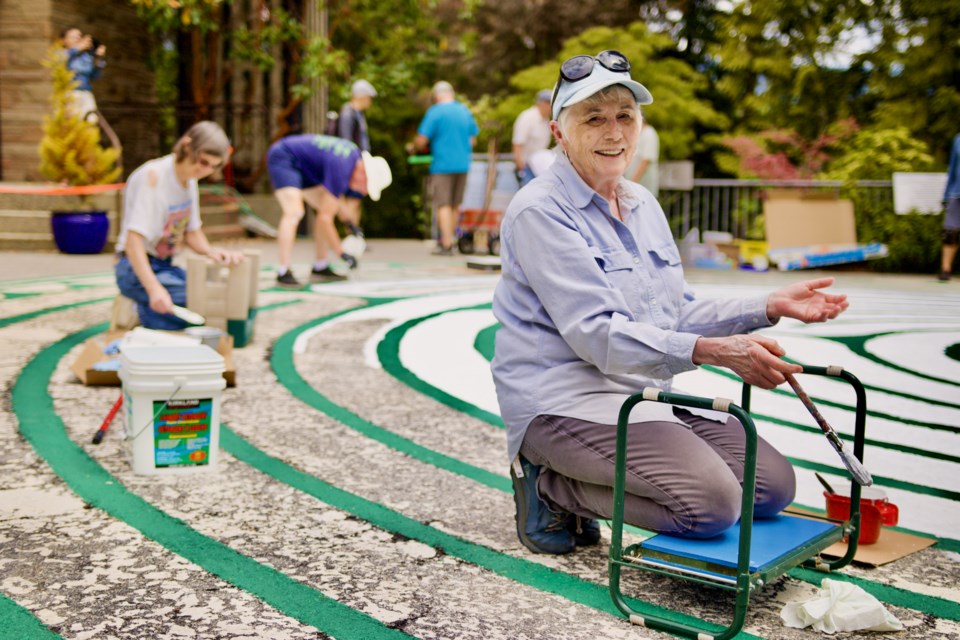For a group of people navigating the twists and turns of challenging circumstances, a labyrinth provided a straightforward path to purposeful community connection.
A project to revitalize one of Sechelt’s most distinctive public artworks — the outdoor labyrinth at St. Hilda’s Anglican Church — last week became the scene of unexpected collaboration.
The painted spiral has been a local fixture for approximately two decades and was overdue for refurbishment. Inhabitants of the shelter for unhoused people temporarily located in the church’s annex approached the parish to volunteer their muscle.
“They reached out in the beginning and offered their assistance at the same time that we were planning to do this,” said Bruce Pond, the project coordinator for St. Hilda’s. “It was good to have this opportunity to share labour and visit.”
A group of two dozen volunteers completed the work on July 12, marking three days of successful effort with a barbecued meal.
In February, the church offered 20 emergency shelter beds for people displaced when the Upper Deck shelter on Sechelt’s Wharf Avenue was damaged by fire. That facility was operated by RainCity Housing, a Vancouver-based nonprofit that supports people experiencing homelessness and other traumas. RainCity now provides two staff members and a security detail for the St. Hilda’s annex, which is open 24 hours a day.
“This is important because [from February onward] we have respected their privacy and their need for peace,” said the Reverend Dr. Steve Black, rector of St. Hilda’s. “Until now there hasn’t been a close connection or an opportunity for that. We have them as co-inhabitants of our space and they are our neighbours, but the labyrinth project provided something that wasn’t there yet.”
Because the labyrinth’s regular maintenance schedule had been neglected during COVID, its faded shapes required careful study before repainting could begin. For expert assistance, St. Hilda’s engaged artist Robert Marion, who has designed community mandalas in Roberts Creek for more than a quarter century.
According to Mandy Hardwick, associate director of Raincity Housing and Support Society, many of the shelter inhabitants have past trade experience as skilled labourers.
“The question came up from those residents,” Hardwick said. “They were asking whether we could do something for the folks at the church. They’ve been so kind to help us out and relocate here. The labyrinth has been well-loved and used but it looks like it could use a little work. It’s not uncommon for us to get involved in community work or efforts to clean up neighbourhoods.”
Labyrinths are geometric designs that encourage spiritual practices like meditation and prayer. Visitors walk the circular path to achieve a state of reflective concentration. Circular patterns have been used for sacred rituals over at least four millenia, including Indigenous medicine wheels and the design at the Chartres Cathedral in France. The St. Hilda’s model is based on the 13th-century Chartres layout, known as a 11-circuit labyrinth.
“We had a lot of meaningful conversations as people painted,” said Meg Stevens, one of the wardens at St. Hilda’s. “We talked about the purpose of the labyrinth. We even had a long dissertation on Bob Dylan.”
The final step will be to choose iconography for the restored labyrinth. The parish committee is considering flourishes inspired by Celtic or medieval lore, and will also contact the shíshálh Nation for guidance on images appropriate to the territory.
Meanwhile, RainCity is focused on a different kind of symbolism. “This visualizes the importance of relationship and community,” said Hardwick. “That is something that our folks are constantly looking for: safe space, a place to be with people who see them as valuable citizens. And a lot of the folks at the church have been able to impart that.”





